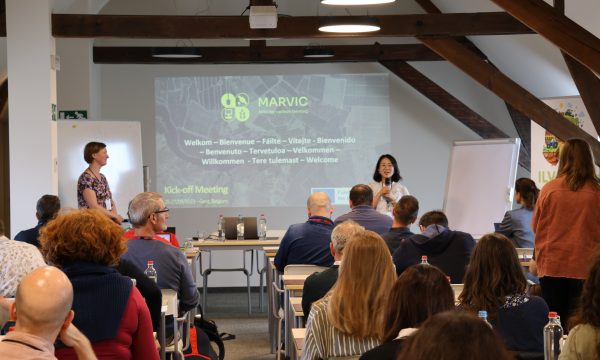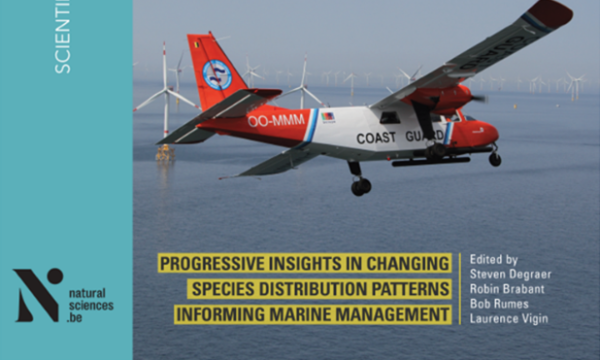Press release Offshore wind farms increase carbon storage in seabeds – useful knowledge for marine spatial planning and climate change models
Marine animals that grow on offshore wind turbines (such as mussels) affect the sea floor. We already knew that, but thanks to recent Belgian-Dutch research results, we now know exactly how important this effect is. The results were presented in two recently published papers. They describe in detail how organic material is concentrated in and around the wind farms and deposited at a greater distance in lower quantities. This leads to increased carbon storage in the seabed of the wind farms, which is important in the context of climate compensation, but also to changes in the fragile benthic fauna. The results can contribute to decision-making on sensitive issues such as the spatial planning of offshore wind farms in marine protected areas and the future decommissioning of offshore wind turbines.
As part of the transition from non-renewable (fossil) to renewable energy sources, the number of offshore wind farms is increasing worldwide. This is also the case in Belgium, currently the fifth largest offshore wind energy producer in the world. A new offshore wind zone, the Princess Elisabeth Zone, is marked on the Belgian Marine Spatial Plan for the period 2020-2026. It will more than double the surface that is set aside for the national offshore wind energy production (from 238 to ca 530 km²) and almost double the capacity (from 2,26 tot > 4,26 Gigawatt). The new zone partly coincides with the Marine Protected Area ‘Vlaamse Banken’, a designated Natura 2000 site under the EU Habitats Directive.

Thirteen years of monitoring of the ecological effects of wind farms in the first Belgian offshore wind zone showed that large quantities of invertebrates (mussels, anemones, small crustaceans etc.) colonize the turbines, and that these in turn attract fish species such as cod and plaice. However, knowledge of the colonizing species and their effects on the marine ecosystem remained largely restricted to the level of individual turbines and wind farms.
Geographical Upscaling
The FaCE-It project (Functional biodiversity in a Changing sedimentary Environment: Implications for biogeochemistry and food webs in a managerial setting), that ran over the period 2015 – 2020, greatly expanded this knowledge.
“In FaCE-It, we studied the effects that offshore wind farms have on the functioning of the marine ecosystem. For the first time ever, we also investigated the effects of multiple offshore wind farms in multiple countries on a large geographical scale. A combination of detailed observations, experiments and model simulations was used, with focus on the effects on the sea floor.” explains project coordinator Jan Vanaverbeke of the Royal Belgian Institute of Natural Sciences.
The project partners report on their findings in two papers in Frontiers in Marine Science.


Changes in Organic Enrichment of the Seabed (Ivanov et al., 2021)
Animals that colonize wind turbines filter food from the water column, and then provide a supply of organic material to the seabed around the turbines, both in the form of their feces and of sinking dead organisms. But where exactly does this organic material end up? This could be verified by models that describe water currents (hydrodynamics, including tides and waves) and sediment transport. These models were linked to knowledge about the dynamics of organic carbon and mineral particles in the water column and sediments. That data integration clearly showed that the presence of offshore wind farms leads to strong changes in the deposition of organic matter on the seabed, both inside and outside the wind farms. Since this organic matter is the food for the organisms that inhabit the seabed, (part of) the food chain may be affected.
Evgeny Ivanov of the University of Liège details: “Within offshore wind farms, and in the areas surrounding them, a significant increase is observed in organic matter deposited on the seabed (up to 15%, and locally even up to 50% more), especially in the areas along the strongest tidal currents (along a NE/SW axis relative to the turbines). In the other directions (to NW and SE), a decrease in organic matter deposition is predicted (up to 10% less). Multiple offshore wind farms will therefore result in a mosaic of areas with increased and decreased carbon deposition to the sea floor. In the wind farms and in an area of 5 km around the turbines the resulting balance is positive (more organic material), while deposition is notably reduced in the surrounding area up to 30 km further away.”

Carbon Storage in Offshore Wind Farms (De Borger et al, 2021)
The increased organic deposition results in increased carbon storage in the seabed within an offshore wind farm. Emil De Borger, at the time at Ghent University and now at the Royal Netherlands Institute of Sea Research (NIOZ), calculated exactly how much carbon is involved: “During the life span of an offshore wind farm (here defined as 20 years), between 28715 and 48406 tons of carbon is stored in the upper 10 cm of the seabed in offshore wind farms. This carbon is sometimes referred to as “blue carbon”, carbon trapped in organic forms (such as animals or plants), which is then buried. Knowing that these numbers correspond to 0.014–0.025% of Belgium’s annual greenhouse gas emissions, this can be considered a small, but nevertheless significant carbon offset.“
This carbon offset comes on top of the much larger amount of carbon (CO2) that is not emitted by using a renewable instead of a fossil energy source. For comparison: In Belgium, CO2 emissions would reduce between 1,04 and 2,86 millions of tonnes by using wind-generated power as opposed to a gas turbine (based on data from 2018). To this, the estimated quantities of carbon that are stored in the sediment contribute an additional 1 to 4.6 %.

Implications for Spatial Planning of Offshore Wind Farms
These findings have important implications for the design of the new offshore wind farms in and near the Marine Protected Area (MPA) of the Vlaamse Banken. Within this MPA, valuable and threatened gravel beds are found, which are home to rare species and are protected by EU legislation. An increase in organic matter deposition in this gravel bed area is not necessarily beneficial for the filter feeding fauna present. The choice of location for the new offshore wind farms will determine the magnitude of the impact on the gravel beds to a much greater extent than the number of turbines, and careful implantation of the turbines is necessary to allow offshore wind farms and gravel beds to coexist in an environmentally friendly manner within the MPA of the Vlaamse Banken.
Using the model developed in FaCE-It, it was calculated that locating the new offshore wind farm at least 3 km downstream of the gravel beds would only result in a moderate increase of organic matter deposition. When the choice would be to locate the offshore wind farms upstream, the recommendation is to respect a distance of 7 km. In the direction orthogonal of the tidal current, a distance of 2 to 4 km is advised.
It is also illustrated that nature knows no geopolitical boundaries. The effects cross national borders: future offshore wind farms in the neighbouring French part of the North Sea will affect the Belgian part, while the operational Belgian offshore wind zone is already affecting the Dutch part of the North Sea.
Carbon storage of a temporary nature?
The increased carbon storage in the sediments in and around offshore wind farms - and thus the climate-regulating effect - may be of limited duration. If the seafloor is disturbed, the accumulated carbon can be released again into the water column. This may happen as consequence of bottom-disturbing activities such as trawling (allowed outside a 50 m radius around individual turbines in the United Kingdom and France, but prohibited completely in Belgium, the Netherlands, and Germany during the operational phases of the wind farms, where it may be allowed again after their decommissioning), or when the concession zones would be restored to their original condition after the expected lifespan of the wind turbines (20–25 years).
Therefore, the FaCE-It results on carbon storage in sediments aren’t only useful in support of spatial planning of offshore wind farms but can also inform decision making on future decommissioning scenarios and methodology. One possible scenario is partial decommissioning, whereby part of the subsea structure remains in place, is repurposed or relocated.
FaCE-It (Functional biodiversity in a Changing sedimentary Environment: Implications for biogeochemistry and food webs in a managerial setting) is a project funded by Belspo, coordinated by the Royal Belgian Institute of Natural Sciences (RBINS), and a cooperation between RBINS, the Marine Biology Research Group of Ghent University, the Department of Astrophysics, Geophysics and Oceanography of the University of Liege, the Flanders Research Institute for Agriculture, Fisheries and Food (ILVO) and the Royal Netherlands Institute for Sea Research (NIOZ).



